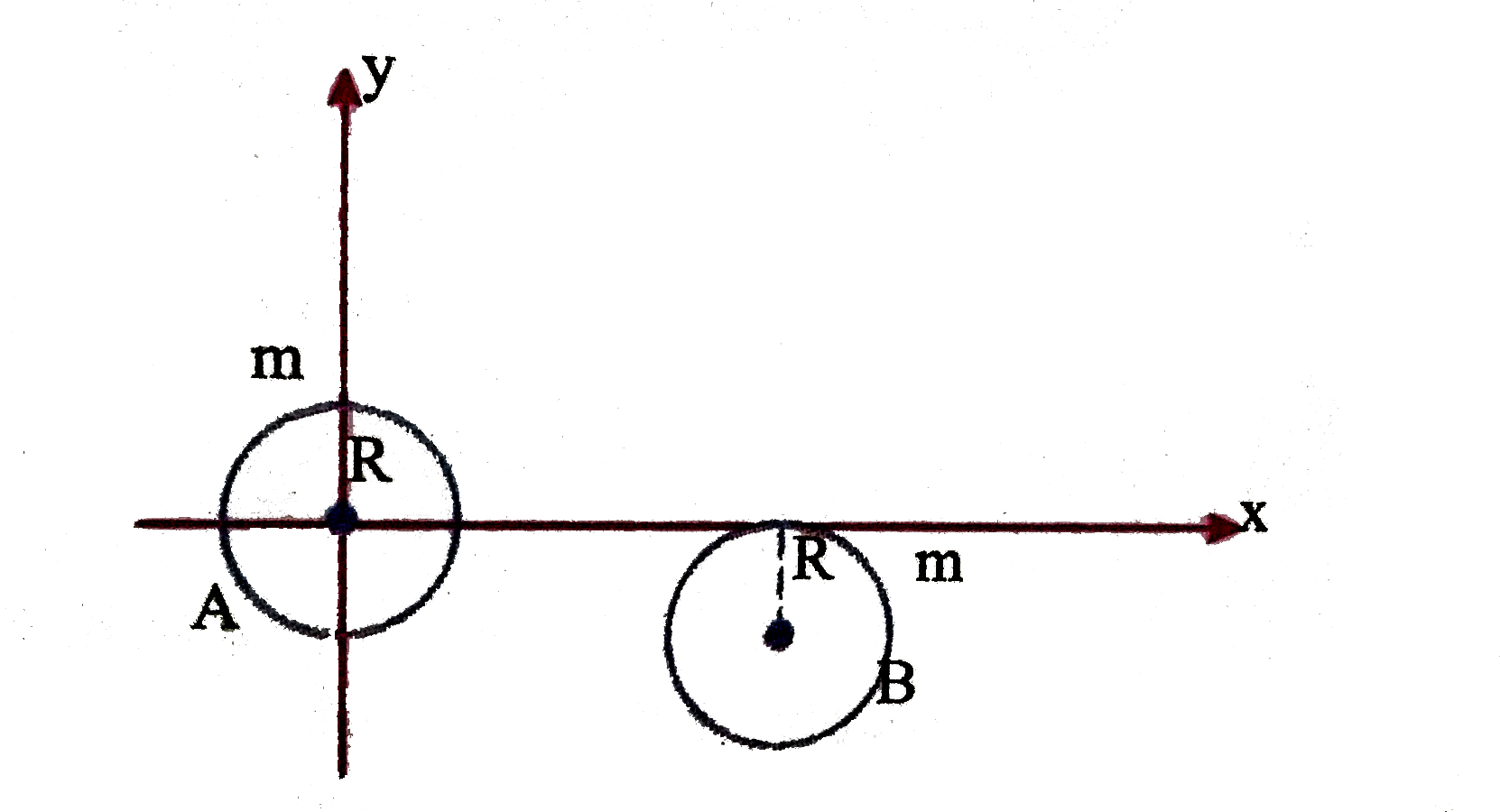Two uniform non conducting balls AandB have identical size having radius R but made of different density material (density of A = 2 density of B). The ball Ais+vely charged and ball B is - vely charged. The balls are released on the horizontal smooth surface at the separation 10R as shown in figure. because of mutual attraction the balls start moving towards each other. They will collide at a point.
 .
.
x=10R3
x=11R3
x=5R
x=7R3
The correct Answer is:A
(a) There is no external force on system (ball A and ball B). The balls moves due to mutual attraction that is internal force to the system. The centre of mass of the system will not move. The will collide at the position of centre of mass is ball A and B It is easy to calculate the position of centre of mass at initial stage.
xcmmA×A+mB×BmA+mB=mA.0+mB.10R(mA+mB)
mA=43πR2ρA and mB=43πR3ρB
As ρA=2ρB⇒mA=2mB
Hence xcm=mB(10R)2mB=103R.
 .
.
Topper's Solved these Questions
- ROTATIONAL DYNAMICSBook:A2ZChapter:ROTATIONAL DYNAMICSExercise:Moment Of Inertia
Explore 39 Videos
- ROTATIONAL DYNAMICSBook:A2ZChapter:ROTATIONAL DYNAMICSExercise:Rotational Kinematics
Explore 19 Videos
- ROTATIONAL DYNAMICSBook:A2ZChapter:ROTATIONAL DYNAMICSExercise:Chapter Test
Explore 29 Videos
- PROPERTIES OF MATTERBook:A2ZChapter:PROPERTIES OF MATTERExercise:Chapter Test
Explore 29 Videos
- THERMAL PROPERTIES OF MATTERBook:A2ZChapter:THERMAL PROPERTIES OF MATTERExercise:Chapter Test
Explore 30 Videos
Similar Questions
Analogue of mass in rotational motion is.
View SolutionA flywheel rotating at 420 rpm slows down at a constant rate 2rads−2. What time is required to stop the flywheel ?
View SolutionA carpenter has constructed a toy as shown in figure. If the density of the material of the sphere is 12 tirnes that of cone, the y− coordinate of COM of toy point O

View Solution
The stress versus strain graphs for wires of two materials A and B are as shown in the figure. If YA and YB are the Young's moduli of the materials then
View SolutionIf mass-energy equivalence is taken into account, when water is cooled to from ice, the mass of water should
View SolutionThe electrostatic potential inside a charged spherical ball is given by ϕ=ar2+b where r is the distance from the centre and a, b are constants. Then the charge density inside the ball is:
View SolutionThe electrostatic potential inside a charged spherical ball is given by phi = ar^(2) + b , where r is distance from the center of the ball, a and b are constants. Calculate the charge density inside the ball.
View SolutionOne spherical ball of radius R , density of released in liquid of density d//2 attains a terminal velocity V. Another ball of radius 2R and density 1.5 d released in the liquid will attain a terminal velocity
View SolutionTwo smooth balls A and B, each of mass m and radius R, have their centres as shown in fig. Ball A, moving along positive x-axis, collides with ball B. Just before the collision, speed of ball 'A' is 4m/s and ball 'B' is stantionary. The collision

Velocity of the ball 'A' just after the collision is
View SolutionTwo smooth balls A and B , each of mass m and radius R , have their centres as shown in fig. Ball A , moving along positive x-axis, collides with ball B . Just before the collision, speed of ball 'A' is 4m//s and ball 'B' is stantionary. The collision What is velocity of ball 'B' after collision is
View SolutionTwo smooth balls A and B, each of mass m and radius R, have their centres as shown in fig. Ball A, moving along positive x-axis, collides with ball B. Just before the collision, speed of ball 'A' is 4m/s and ball 'B' is stantionary. The collision

Impluse of the force exerted by 'A' on 'B' during the collision is equal to
View SolutionTwo smooth balls A and B, each of mass m and radius R, have their centre at (0,0,R) and (5R,-R,R) respectively, in a coordinate system as shown. Ball A, moving along positive x-axis, collides with ball B. Just before the collision, speed of ball A is 4m/s and ball B is stationary. The collision between the balls is elastic. Velocity of the ball A just after the collsion is
View SolutionA smooth ball A travels towards another identical ball B with a velocity u. Ball B is at rest and the impact parameter d is equal to sqrt(3) R where R is radius of each ball. Due to impact the direction of motion of ball A changes by 30^(@) . Find the velocity of B after the impact. It is given that collision is elastic
View SolutionOn a horizontal table, there is a smooth circular groove of mean radius R. The walls of the groove are non conducting. Two metal balls (each having mass m and radius r) are placed inside the groove with their centers R apart. The balls just fit inside the groove. The two balls are given charge + 3q and – q and released from state of rest. Ignore the non-uniformity in charge distribution as the balls come close together and collide. The collision is elastic. Find maximum speed acquired by each ball after they collide for the first time.
View SolutionA ball is released from point A as shown in figure. The ball leaves the track at B. All surfaces are smooth.

If track makes an angle 30∘ with horizontal at B, then maximum height attained by ball will be
View Solution

